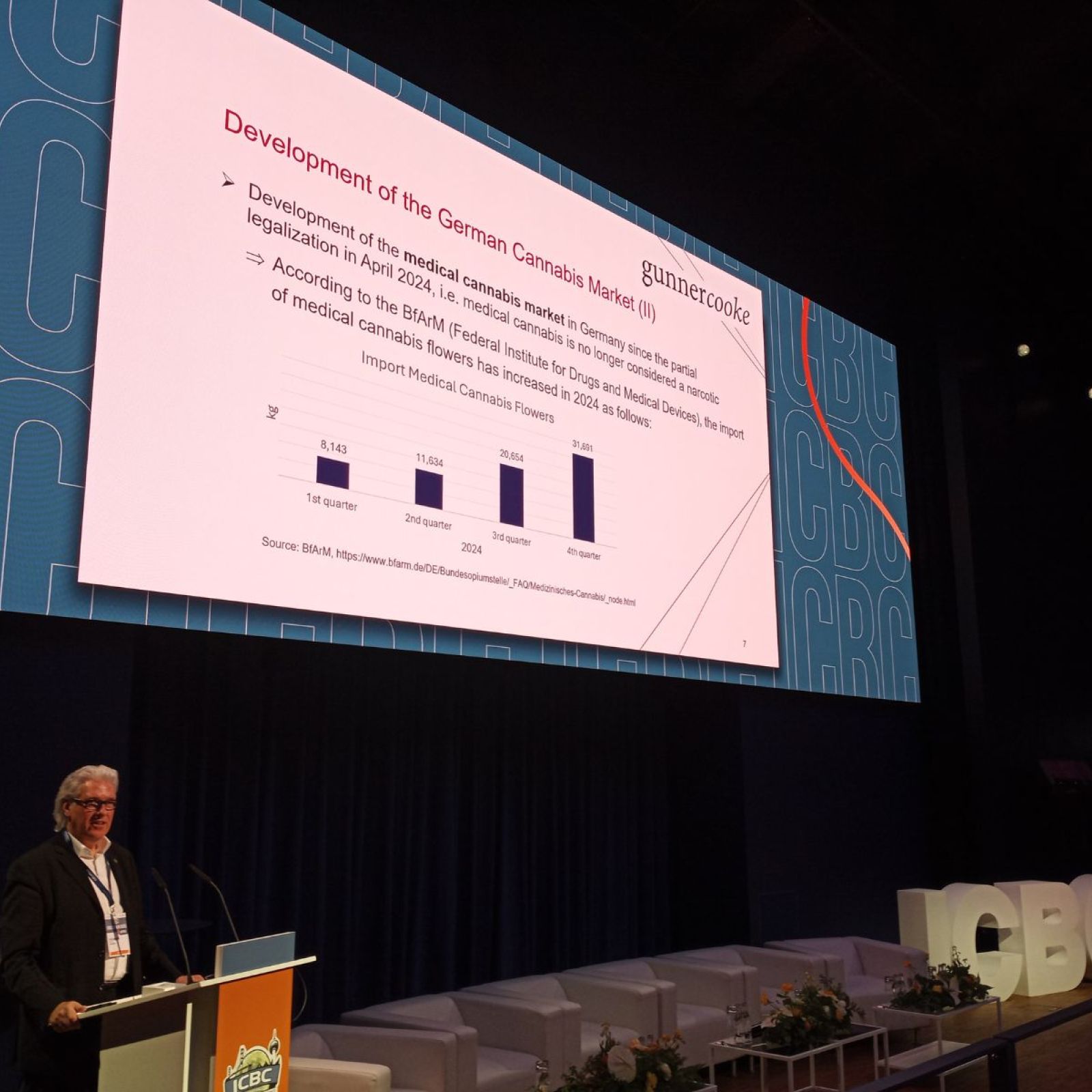
International Interest In Europe’s Cannabis Market Is Surging

International Interest In Europe’s Cannabis Market Is Surging
As cannabis entrepreneurs, investors, policymakers, regulators, and industry service providers descended upon Germany in recent days for the International Cannabis Business Conference week, one thing is very evident: worldwide interest in Europe’s emerging legal cannabis market is surging.
I am based in the United States (Oregon), and having spent the last week in Germany surrounded by representatives from nearly every legal cannabis market on earth, and witnessing things on the ground firsthand, I can safely say that Europe’s status as being the most exciting place for cannabis policy and industry is officially here.
People from every corner of the globe are scrambling to gain a meaningful footprint in Germany and other legal markets in Europe, and rightfully so. Europe’s Green Rush era is in full swing.
In a lot of ways, what is happening in Europe right now reminds me of what occurred in the United States from 2012-2016 when the first of our states approved modernized adult-use cannabis laws. As many of us from the U.S. who attended The Talman House and International Cannabis Business Conference events this week in Berlin discussed, it felt like going back in time, and that we were re-watching a movie that we had already seen.
Yet, in other ways, the emergence of the modernized European cannabis industry is completely unique with its own nuances, opportunities, and challenges. There are certainly many components of the legal German cannabis industry’s rise, and to a lesser extent, other European markets, that are similar to what happened in the United States and Canada years ago. But some things are entirely new.
Knowing what the similarities are between North America’s experience and Europe’s, and equally important, what is not similar, is paramount for everyone who wants to succeed. Right now, Europe has the chance to incorporate the best of what has happened in the U.S. and Canadian markets and to learn from North America’s mistakes and failings.
Members of Europe’s legal cannabis community, along with policymakers and regulators, have a golden opportunity to create something better than the world has ever witnessed before. It is up to all of us, from entrepreneurs to investors to government officials, to capitalize on this historic moment and not squander it.
The biggest positive lesson that has come out of the United States and Canada that Europe must learn from is that when given the legal option to do so, consumers and patients will make their purchases from regulated cannabis channels instead of making those purchases from unregulated sources, provided that policies and regulations are sensible.
What constitutes ‘sensible’ is subjective and leaves a lot of room for interpretation. However, we now objectively know that in legal North American markets, robust access to reasonably regulated legal cannabis commerce will decimate the unregulated industry. Consumers and patients clearly prefer to make their purchases from commerce channels that have set hours of operation, on-time delivery and/or storefronts, and tested products. Unregulated sources do not offer any of those things.
Conversely, in North American markets where overburdensome regulations and illogical policies were implemented, the unregulated market continues to thrive. The data is clear that consumers and patients are willing to pay a little extra for regulated products. But there comes a point when regulations and taxes drive up costs to such an extent that it deters legal purchases, at which point people continue to buy their cannabis products from unregulated sources.
In my ongoing discussions with top European legal cannabis expert Peter Homberg of gunnercooke, he often points out that there are three goals of German cannabis policy modernization efforts. The three goals, which Mr. Homberg touched on in his keynote address on day 1 of the International Cannabis Business Conference in Berlin, also extend to other EU markets (paraphrased below):
- To protect children.
- To boost public health outcomes.
- To hinder the unregulated market.
The first two items on the above list flow from the third, and success can only be achieved by recognizing the reality that consumers and patients are going to purchase and consume cannabis products, and they must be afforded the legal options to do so.
European lawmakers and regulators who wish to stick their heads in the sand and act as if prohibition or overburdensome regulations will somehow magically reduce European cannabis consumption do so at their own peril, and at the peril of public health and other outcomes. That is particularly true in Germany, where the launch of regional adult-use cannabis commerce pilot trials has experienced several delays, and where conservative members of the newly elected governing coalition have expressed a desire to scrap pilot trials and other legalization provisions entirely.
Such members of the German governing coalition are, presumably as a political strategy, refusing to recognize a key point – that regional adult-use cannabis commerce pilot trials are not a new thing and are already successfully operating in the Netherlands and Switzerland. Just as the sky has not fallen over those EU nations, the same will prove to be true if the incoming German Minister of Health Nina Warken, and the recently announced Federal Ministry of Food and Agriculture (BMEL) Alois Rainer, allow already-submitted pilot trial applications to proceed.
For an insightful and thorough examination of both Nina Warken and Alois Rainer, both of whom will be instrumental in overseeing Germany’s emerging cannabis industry in the near future, check out a recent article by krautinvest.
A major difference between the North American markets and what is being built in Germany and Europe is the European Union (EU), as well as the EU’s politically independent executive arm, the European Commission (EC). All member nations are bound by EU agreements and EC policies and processes, and while state-level markets in the U.S. operate under the federal umbrella, it is not the same dynamic compared to the EU/EC.
EU agreements prohibit adult-use commerce models found at the state level in the United States and what is in place in Canada at a national level. Medical cannabis commerce is permitted in the European market, but adult-use commerce is limited to models that are based in research and designed to help boost public health outcomes, such as pilot trials and cultivation associations.
Those limitations need to be addressed via continued lobbying of continental decision-makers, and while many of them may be committed to ignoring demands to modernize EU agreements, the demands and pressure must be consistently applied nonetheless.
A significant lesson learned from ongoing policy and regulatory implementation in the United States is that a ‘patchwork’ approach is inefficient and chaotic, and ultimately doesn’t work for anyone. In the U.S., every legal state operates in a siloed fashion, with each jurisdiction having its own laws and regulations, and yet each state is also governed by conflicting federal law.
The same dysfunctional dynamic is on display in the EU to some degree, where individual nations have their own set of industry rules, which are then overlapped by an additional layer of EU-level rules that are either vague, conflicting, or in some cases, outright harmful. It is vital that the EU modernize and harmonize agreements and other policies in such a way that it recognizes reality and provides better certainty for patients, consumers, industry members, and ultimately, governments.
Europe’s cannabis industry and advocacy communities must continue to educate the rest of European society about the benefits of sensible policy modernization and the harms of senseless cannabis prohibition laws and regulations.
All the eyes of the global cannabis community are fixated on what is happening in Germany and other emerging European markets right now, including and especially the eyes of policymakers and regulators. Members of Europe’s emerging industry need to be mindful and strive to be good stewards of the opportunity that is being afforded to them. Germany’s industry and other legal markets in Europe are under a microscope right now, and that will remain the case for the foreseeable future.
I was asked many times while I was in Berlin for the International Cannabis Business Conference week what I consider to be the biggest lesson that entrepreneurs and investors can learn from the U.S., and my answer was always the same: don’t let your emotions get the best of you. Always perform your due diligence and make your decisions based on a sound process that you would apply to any other large, emerging industry.
Cannabis is exciting, and Europe’s industry potential is enormous. But if you don’t anticipate how fierce the competition will be, and recognize that industry success will not involve a straight path, you can lose a lot of money really fast.
I will end this article with a word of caution, as someone who had a front-row seat to how things unfolded in the United States years ago. We are all in this era of European cannabis together, and a single wrong move by one person or entity will no doubt be applied by cannabis opponents to the rest of Europe’s industry.
This special and historic moment in time can never be repeated, and we need to learn from the mistakes made in North America and ensure that things are done right in Europe to help put in place a foundation and framework that will set the stage for years to come. Proceed accordingly.
Share article
Ticket Prices increase
JANUARY 28

Ticket Prices increase
JANUARY 28

Join Our Awesome Community
Join Our Awesome Community
Join Our Awesome
Community
Get all the latest industry news
delivered to your inbox







